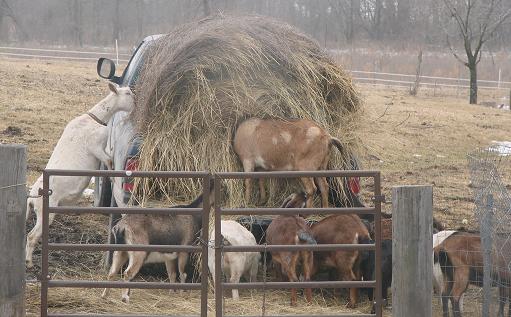Kansas City Food Circle - Member Grower
SIMPLE FOOD FARM UPDATE - JUNE 2010
We are a family of three wanting to move off our farm in Kansas to start a larger venture. Our ideal situation would be a sustainable organic homestead for us to live and work on full time.
We are college educated, been farming all our lives, and ready to make the move to a longer growing season. We are open to do a lease-to-own, crop share, or co-own and operate etc. We are energetic, highly motivated self-starters with extensive know-how and experience in all aspects of organic/biodynamic/sustainable/perma-culture growing and marketing, composting, dairy/meat goats, equine, and poultry and basic maintenance to manage a farm. We prefer to live off grid.
Please feel free to contact us for more detailed information, resume, and interview.
Angela Rothweiler
913-660-6282
~~~~~~~~~~~~~~~
View all
~~~~~~~~~~~~~~~
Simple Food
Angela Rothweiler
New Lancaster Rd
Paola, KS 66071
cell 913-660-6282
farm 913-548-3942
greenergirl (a) gmail.com
http://www.localharvest.org/farms/M32512
We are an organic homestead providing an excess of free-range chicken eggs, dairy goats, and heirloom produce. We utilize biodynamic methods and sustainable companion planting practices.
We are open to giving homestead tours and samplings. You may even come out for some chores. Yes, you can feed my animals. Please bring all organic vegetable/fruit scraps, raisins, crackers or bread. Our dairy goats favor beet tops and bananas; they will even eat the peel.
I also make yogurt, cheese, and keifer (kefir).
Weekly deliveries made to Olathe, KS.
—
Here is a list of some of this years produce to come:
Tomato, Black Cherry
Tomato, Livingston’s Golden Queen
Tomato, Brandywine Red
Spinach, Bloomsdale Longstanding
Carrot, Cosmic Purple
Carrot, Gold King
Beet, Early Wonder Tall Top
Beet, Burpee’s Golden
Pepper, Golden California Wonder Bell
Cauliflower, Snowbal
Onion, Texas Early Grano
Sunflower, Giant Greystripe
Corn Salad
Arugula
Calendula
Cumin
Brussels Sprouts, Long Island Improved
—
===========================
POSTED in MARCH, 2010:
Free Horse/Goat Manure 4 compost
That’s right I got an acre full you haul. I have a wheel barrel and some shovels to borrow to load.
I am a source of manure and (used) hay for Kansas side.
Angela Rothweiler
35022 New Lancaster Rd
Paola, KS 66071
greenergirl (a) gmail.com
===========================
Arugula is a spicy plant that has been grown as a salad green in Europe for many years.
It is also known as rocket or roquette and is popular in Italian cuisine.
It is typically ready to harvest in thirty to forty days.
It also makes a nice addition to soups and sauced when puréed with other herbs like sorrel and garlic.
It thrives in cool weather so plant in successive plantings, early in the spring to summer.
Cumin is an annual that is low growing, about six inches tall, has dark green leaves and reddish flowers.
The seeds are collected and dried and used whole or powdered to add some “heat” to recipes.
Long Island Improved
110 days — Closely set, tight, firm, dark green, 1-1/2 inch sprouts are set on a 20 to 24 inch tall plant over an extended period. It freezes well. This standard old variety, dating back to the 1890s, was the commercial variety grown in California until the more uniform maturing hybrids became popular.
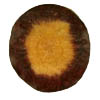 Cosmic Purple (carrot)
Cosmic Purple (carrot)
60 days — Thanks to the work of Dr. Philipp Simon and staff at the USDA ARS in Madison, Wisconsin, a whole rainbow of colored carrots are becoming available. Although purple colored carrots have been cultivated in Afghanistan, Turkey and Middle East since about 900 A.D., this variety was released in 2005.
It is bright purple on the outside and orange on the inside. They make an interesting and tasty, sweet addition to a veggie platter. Six to eight inch long, sweet Danvers-type carrot.
According to the USDA[1], purple carrots contain the pigments (and antioxidants) anthocyanin, beta carotene and alpha carotene which they report as benefiting health by helping to prevent heart disease and strokes.
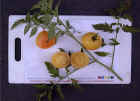 Golden Queen (tomato)
Golden Queen (tomato) ![]() - Indeterminate. Introduced in 1882. The standard catalog description over the years claim have been fairly consistent. Characteristically described as the “Queen of all the Yellows”, “Of superior flavor”, “it is solid, always smooth, entirely free from ridges”, large in size, ripens early. Fine for slicing, ripens early, 78 days.5, 13
- Indeterminate. Introduced in 1882. The standard catalog description over the years claim have been fairly consistent. Characteristically described as the “Queen of all the Yellows”, “Of superior flavor”, “it is solid, always smooth, entirely free from ridges”, large in size, ripens early. Fine for slicing, ripens early, 78 days.5, 13
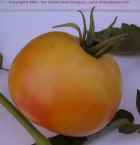 Referring to the history of the ‘Golden Queen’, in his own words in his book entitled “Livingston and the Tomato“, he writes, “In one of the county fairs which I often attended for the purpose of selling seeds, I saw a very pretty yellow tomato. As I was examining it closely, and admiring it, the owner saw fit to make a present of one of them, which I highly prized, and took special care to preserve, test and improve. I had it a number of years before I released it; but in 1882 I thought it advisable to give it a wider circulation, and so advertised it extensively under the above name.“3
Referring to the history of the ‘Golden Queen’, in his own words in his book entitled “Livingston and the Tomato“, he writes, “In one of the county fairs which I often attended for the purpose of selling seeds, I saw a very pretty yellow tomato. As I was examining it closely, and admiring it, the owner saw fit to make a present of one of them, which I highly prized, and took special care to preserve, test and improve. I had it a number of years before I released it; but in 1882 I thought it advisable to give it a wider circulation, and so advertised it extensively under the above name.“3
Several companies are selling yellow fruited tomatoes called Golden Queen. Our seed was grown out from stock obtained from the National Seed Storage Lab and is true to the original descriptions.
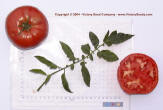 Brandywine, Red (tomato)
Brandywine, Red (tomato)
80-100 days, indeterminate — It is by far one of the best known heirloom tomato varieties. There is a lot of lore surrounding the ‘Brandywine’ category of tomatoes.
Reportedly it is an old Amish heirloom, dating back to 1885 and named after Brandywine Creek in Chester County, Pennsylvania.
The disease tolerant, regular leaf plants yield fruits that are red, globe shaped, and full of flavor. Our parent stock is from heirloom tomato collector Craig LeHoullier who got the seed from Landis Valley in the early 1990s.
Gold King
70 days — Stump-rooted, slightly tapered, two and one-half inches by six inches and does very well in heavy soils. Uniform reddish-orange color. Very sweet and tasty.
Burpee’s Golden
55 days — This dual purpose variety was bred and released by W. Atlee Burpee Company. Reportedly available since about 1828. Similar to, and possibly the same as, ‘Golden Detroit’.
The immature leaves are an attractive green with yellow stems and can be used raw in salads. More mature tops have a mild flavor when cooked as greens or sautéed.
The roots are sweet, a dark golden color with the flesh deep yellow, and are excellent pickled, boiled, steamed, stir fried, or grated raw into salads. They retain their sweetness very well. The flesh does not bleed like red beet.
 Early Wonder Tall Top (beet)
Early Wonder Tall Top (beet)55 days — This variety yields crimson-red flesh with flattened globe-shaped roots and tall, bright, dark green succulent tops. You can use the tender leaves for greens and the dark red roots for salads, pickled, borsch or cooked. Originally introduced to the United States in 1811.
| Recipe for Cooking Greens |
| Tender leaves are picked from the plants and cleaned by soaking in a sink full of water in which a little salt has been added. Larger leaves tend to become tough and bitter with age. Depending on the amount of dirt or bugs present, repeating this process with fresh water may be necessary. For 4 to 6 servings, you will need enough greens to tightly pack a small (6 quart) stock pot. About two pounds will suffice.Into the stock pot, pour two cups of water and about a half teaspoon of sea salt (or to taste). In classic Southern-style, bacon grease is added for flavor and mouth feel. A little fine flavored olive oil may accomplish a similar effect for vegetarians.
Add the greens to the pot by tearing and breaking them apart into bite-sized pieces. You can also chop the greens if you wish. Pack the greens into the pot, cover, and simmer over a medium low flame, stirring often, for two hours. In the last 30 minutes of cooking, various garnishes are added. It is this last step that sets different family recipes apart. Try finely diced onion, garlic and your favorite pepper sauce. Greens are typically served as a side dish with cornbread and pepper sauce.
|
70 days — Same as California Wonder but the peppers are a bright gold, changing to orange-red when mature.
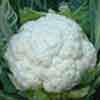 Snowball (Early Snowball)
Snowball (Early Snowball)55 days — Uniform maturing, smooth, pure white heads weighing three to five pounds and six inches across. It is a medium sized plant with good leaf coverage. Released in 1941. It is reliable. Freezes well also.Texas Early Grano 502 PRR
180 days — A “Vidalia-type” onion with excellent eating quality. The globes are uniform in shape, a nice straw colored skin and have white flesh. They are good flavored with a mild to medium pungent taste. They reportedly show a strong tolerance to pink root rot (PRR). This variety was released by the Texas Agricultural Experimental Station in 1944.
SUNFLOWER - The seeds are tasty raw or roasted and lightly salted. They can be used as a snack, or the meats make a nice addition to bread, rolls, or as a topping to a green salad.
Can also be used as a high protein bird or chicken feed.
Harvest the seeds when the seeds look mature, the petals are all dried and the back of the flower heads have turned yellow. Cut from the stalks and hang upside down in a warm dry place. Rub the seeds out of the head when they come out with little coaxing. Allow the seeds to continue to cure until the shells are brittle and crack easily between your teeth.
The seeds are tasty raw or roasted and lightly salted. They can be used as a snack, or the meats make a nice addition to bread, rolls, or as a topping to a green salad.
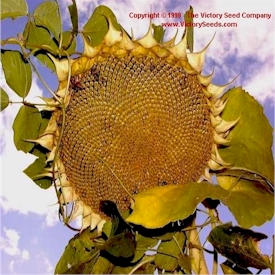
Corn Salad is used extensively in Europe both raw as salad vegetable and cooked as a pot herb.
Sow seeds thickly, 1/4″ to 1/2″ deep, in rows spaced one foot apart. Seeds should emerge in 10 to 20 days. When the plants have three to four leaves, thin the plants to four inches apart.
In colder climates, you can sow seeds indoors, four to six weeks prior to transplanting or directly outdoors as early in the spring as the ground can be worked. This will yield an early summer harvest. You can also plant in the late summer for fall harvest or late fall for spring harvest.
Corn Salad - Valerianella
60 days — Cornsalad is a hardy annual that grows well to zone 5. In warm weather it bolts to seed. If your climate is mild, it can be grown as a winter green.It grows wild in parts of Europe, northern Africa and western Asia and is a common weed on both cultivated land and waste spaces.
Like other formerly foraged greens, corn salad has many nutrients, including three times as much Vitamin C as lettuce, beta-carotene, B6, B9, Vitamin E, and omega-3 fatty acids.
This is an old garden green. It is a mild flavored green that contrasts nicely with stronger flavored greens in salads. It can also be cooked like spinach or used in dishes.
Back to KCFC Member Growers Listing
View or Download our current Directory of Local Organic and Free Range Growers

